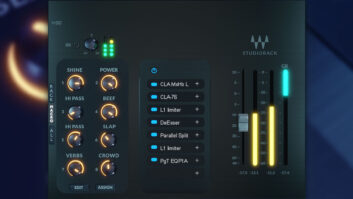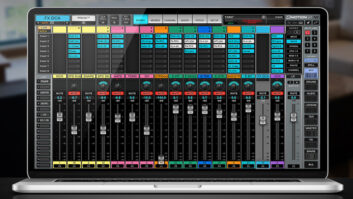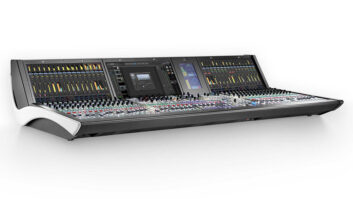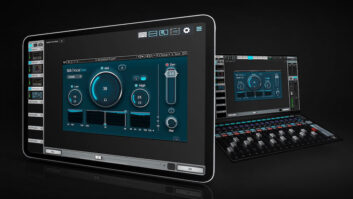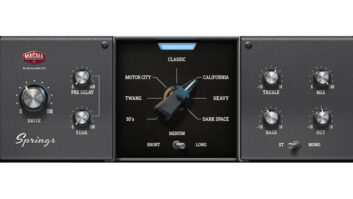Waves Q-Clone test subjects included a vintage Minimoog Model D lowpass filter.
For the DAW-based among us, Waves’ Q-Clone is a brilliant new approach to plug-in EQ, allowing you to slap the sound of your favorite hardware EQ onto as many tracks as you like. We’re not talking about modeling or mere simulation; the real-time convolution process lets you turn a knob on your hardware and hear its actual circuitry adjust the sound of each track as though you had racks full of that device.
SEND AND RECEIVE
The 24-bit Q-Clone comprises two component plug-ins: Q-Capture and Q-Clone. Sending a continuous series of short-frequency sweep impulses, Q-Capture constantly samples the response of an attached hardware EQ, with each impulse essentially generating a “snapshot” of its sound that gets sent through an internal port to the Q-Clone plug-in, which you hear.
To set up Q-Clone, place Q-Capture on any available mono auxiliary channel or dedicated audio track (depending on your host) and assign its physical output to your EQ’s input. In turn, set Q-Capture’s input to receive the EQ’s output. Once the loop is complete, Q-Capture’s mode status changes from Waiting to Receiving, indicating that the setup is correct and ready to use. Put Q-Clone on any live input channel, audio track, bus or aux that you want to process, and it automatically communicates with Q-Capture.
CAPTURING THE MOMENT
When an instance of Q-Clone is first launched, it loads in Hold mode with a flat EQ response. In this mode, the plug-in is equalizing using the filter currently in sample memory and not yet actually processing using your external hardware. Pressing the Capture mode button sets Q-Clone’s ears listening; the response graph updates to reflect the frequency curve of the attached EQ, and you hear the results.
Once you’ve adjusted your hardware EQ to a setting that you like, you can hold it or save the convolved curve as a user preset. One important thing to note, though, is that the cloning process is a linear one. It will not replicate distortion, resonant feedback, noise, dynamics or other nonlinear properties. Although Q-Capture is a mono-only component (whether it is sampling a mono or stereo device), the Q-Clone component can be launched in mono or stereo, with a stereo instance applying the same EQ settings to both channels.
REACHING FOR THE OUTBOARD
To put Q-Clone through its paces, I sourced two of the most distinctive-sounding desk EQs in the business: an SSL E242 and API 550a. Dialing up some familiar curves on an SSL E242 “black” EQ, I immediately appreciated the benefits of combining the tactile control of original hardware with the flexibility of software. Q-Clone replicated the characteristic sound of the filters and their phase responses.
Using HTDMs in Pro Tools; up to 25 instances run comfortably on a dual 2.5 G5 or P4 3.6.,
A handy A/B button allows you to have two settings open at a time. Using the Add mode button, combine these presets or tweak the curve or preset in memory using your outboard; essentially, you can mix and match pieces of EQ hardware as if they were chained together. This can be extremely useful in turning a 4-band EQ into an 8-band, for instance, or for melding favorite frequency-specific properties from multiple devices. For example, I “overwrote” the low-end portion of the E242’s curve with an API 550a module, leaving the SSL’s high end untouched. There is no limit to how many times you can add to and drastically alter a curve’s appearance. This flexibility to “build” also increases the likelihood of boosting Q-Clone to the point of clipping, so I found that the trim control just beneath the gain fader was necessary to keep levels under control on more than one occasion.
I also processed several of my beloved analog synth filters, including an early serial-number Minimoog Model D lowpass. This was a true test, I felt, of how well Q-Clone interprets cut-offs and high-slope filters. The richness was pure and unmistakably true to the Mini, picking up every ounce of resonance and contouring. I was blown away.
Unfortunately, only a single instance of Q-Capture will work at a time — you can’t have two or more hardware EQs online for editing simultaneously. It became apparent that owning two or three unique EQs sitting beside your mouse/DAW controller is ideal, with the freedom to pick and choose and apply them at length across an entire mix — in essence, emulating a large-format console sound for pennies on the dollar.
FREQ’N COOL
The ability to run your favorite outboard EQ on as many tracks as you like is pure genius. You can roughly squeeze 25 native or HTDM instances on a dual 2.5 G5 or a P4 3.6, though I would love to see a full TDM version to extend this number on my Pro Tools|HD3 Accel rig. Even if you don’t own a classic analog hardware EQ, I guarantee that one session with Q-Clone will inspire you to become a vintage gear junkie. I can also imagine a whole new Q-Clone user community eagerly uploading presets of their cherished outboard, making the investment even more rewarding than simply sampling your own gear. Q-Clone could become the only EQ plug-in you’ll ever need.
Price: $1,000, native/HTDM.
Waves, 865/909-9200, www.waves.com.
Jason Scott Alexander is a producer/remixer who develops frontier technologies for the recording industry and commercial radio.

